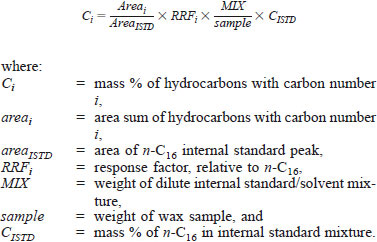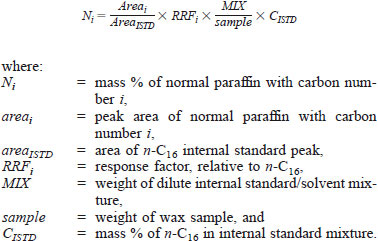11. Procedure
11.1 Prepare a solution of the petroleum wax sample for analysis as follows:
11.1.1 Obtain a petroleum wax sample specimen as directed in 8.1.
11.1.2 Accurately weigh about 0.0100 g of the wax specimen into a glass vial of approximately 15-mL capacity. Add approximately 12 mL of the dilute internal standard solution (0.005 mass % n-C16 in cyclohexane), cap the vial and determine the exact weight of dilute internal standard solution added. Record both weights.
11.1.3 Agitate the vial until the wax is dissolved, using gentle heating if necessary.
11.1.4 For manual syringe injections, fill the syringe directly from this vial. For automatic syringe injections, transfer a suitable aliquot to the appropriate autosampler vial.
11.2 Before analyzing wax samples, program the column temperature to the maximum temperature used. Once the column temperature has reached the maximum, cool the column to the selected starting temperature, and allow it to equilibrate at this temperature for at least 3 min. Without injecting any material, initiate a blank run by starting the temperature program, recorder, and integrator and allow to continue until at least 2 min after the retention time of n-C44. Store a record of this blank run in the computer or integration device for subtraction from the sample area.
NOTE 2 - Some commercially available gas chromatographs have software routines as part of their standard systems to make the baseline correction directly to the detector signal. With such systems, no computer subtraction of the blank is necessary.
11.3 Following the same procedure as for the blank run (see 11.2), inject 0.5 to 1.0 µL of the wax sample solution from 11.1 into the cool on-column injection port. Immediately start the temperature program, the recorder, and the integrator, and store the acquired detector signal.
11.4 Integrate the stored detector signal twice, using the baseline construction parameters as directed below.
11.4.1 Using a valley to valley baseline construction, integrate the detector signal to obtain an area (see Fig. 1) for each peak in the chromatogram. Based on the retention times determined in 10.1, identify the normal paraffin peaks and tabulate only their areas. Also record the area of the n-C16(hexadecane) internal standard peak that must be completely resolved (baseline separation) from the wax sample area.
11.4.2 Using a vertical drop to a horizontal baseline construction (see Fig. 2, Fig. 3), integrate the detector signal a second time. Sum the area of all the peaks of each carbon number and tabulate these totals. By convention, the peaks assigned the carbon number n are those that elute between the valley immediately following the normal paraffin peak (Cn-1) and the corresponding valley following the next normal paraffin peak (Cn).
11.4.3 To ensure proper and consistent integrations, plot the chromatogram with drawn in baseline after each integration and confirm that the baselines match Fig. 1 and Fig. 2.
11.4.4 Do not include, as part of the sample, any peaks resulting from the solvent or the internal standard.
NOTE 3 - The total area for each carbon number can be measured by either pre-programming the integrator to sum the area of the peaks within the appropriate retention time windows or by analyzing the peak area data after the peak integration process is complete.
12. Calculation
12.1 Each Carbon Number - Calculate the mass % for each carbon number determined in 11.4.2 using Eq 3.

12.2 Normal Paraffin - Calculate the mass % of each normal paraffin hydrocarbon from the individual areas determined in 11.4.1 using Eq 4.

12.3 Non-Normal Paraffin Hydrocarbon - The non-normal paraffin hydrocarbons are calculated as the difference between the mass percent of hydrocarbons with carbon number i (Ci) and the mass percent of the n-paraffin with carbon number i (Ni):
NONi = Ci - Ni
where:
NON(i) = mass percent of the non-normal paraffin hydrocarbons of each carbon number.
12.3.1 The response for all components in a carbon number is assumed to be the same as the response for the normal paraffin of the same carbon number as determined in 10.2.
12.3.2 Relative response factors for individual n-paraffins between those determined from the calibration mixture are obtained by interpolation.
12.4 Calculate the mass percent Of C45+ according to Eq 6:
mass % C45+ = 100 % - ∑Ci
where:
∑Ci = the sum of the mass % of all detected hydrocarbons.



